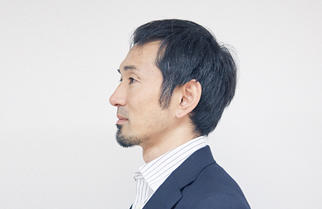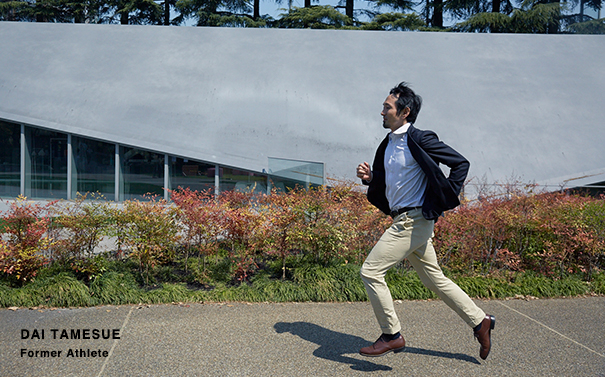
79 Dai Tamesue(Former Athlete)
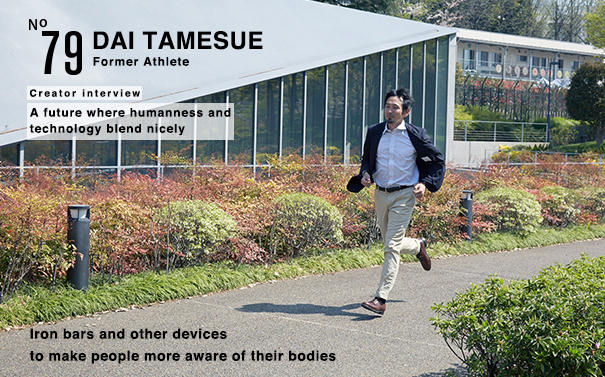
Dai Tamesue is the first Japanese to win a medal for sprint at a World Competition. Ending his athletic career in 2012, Tamesue is now a commentator and is engaged in a wide range of activities. He was one of the directors of the "ATHLETE" exhibition currently being held at 21_21 DESIGN SIGHT. In this interview, we asked him about Roppongi, the future, and athletic ability and Tamesue provided us with interesting insight.
Streets should allow for many different human movements
You are asking me how we could turn Roppongi into an area for athletes.. Well, I think you should place iron bars in the streets. (laughs) It all depends on what you mean by the word "athlete."
When I look at towns in Japan, I feel that the streets have not made on the premise that people move in many different ways. That's why problems occur when there are people who move a little differently from the others. Sometimes, when I'm running at night through places like Nishi Azabu and Roppongi, I feel that not much thought has been given to runners. It's as if runners are expected to go elsewhere.
When I go abroad, I see people walking and running in the streets and middle-aged men on bicycles, and of course, people in wheelchairs. There seems to be an understanding that space is needed for all kinds of people to move about.
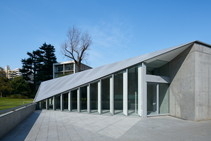
21_21 DESIGN SIGHT
A design facility that was set up on the grounds of Tokyo Midtown in 2007. It has held a total of 34 exhibitions so far. Marking its 10th anniversary, a new space called Gallery 3 was opened on within the museum on March 31, 2017. A series of events are being held at dubbed "Open Conversations" where creators discuss the future of 21_21 DESIGN SIGHT. Photograph: Masaya Yoshimura
Unpredictability and space strengthen athletic ability
There is the word "affordance" [the movements of animals based on feedback they get from their surrounding environment]. People have reflexes, and they try to be in line with the outer environment, unconsciously moving in certain ways.
I feel that cities in Japan have been made in a way that makes it too easy for people to get from home to office without thinking. Once you get out of the ticket gate, you just automatically move with the flow of crowds to the office building, and you only start becoming slightly alert when you get on the elevator. In contrast, the places that athletes like to go to for training camps are places in nature - namely, places where the ground is uneven and where there are few straight lines. Athletes choose places with randomness, with bumpy grounds and winding roads.
There are two opposites - adapting to the environment and being self-assertive - and athletes are people who are at a halfway point between the two. So they need to be in environments that have not been too thoroughly designed and which allow them some creative space. I think that an environment that has absolutely no irregularity or space is detrimental to athletic ability.
The user-unfriendly sports grounds in Japan
A city I like is The Hague in the Netherlands where I have been to for residential training. There is a sports ground that has running tracks surrounded by buildings like schools and facilities for the elderly. In the morning, granddads come out to play pétanque, and the children have their sports class. At noon, the mothers come to have lunch, and in the evening, the fathers come for their soccer club activities, and other people come to drink beer.
While training from morning till night, I saw all these people, and I really loved the way that sports and daily life were mixing so naturally.
There are many fine sports grounds in Japan, but you have to go through very tiresome procedures to use them, and I personally feel that that they are the least user-friendly in the world. When using the sports ground at The Hague, all I had to do was to meet the superintendent and introduce myself. The doors were left unlocked and the facilities were always available for use. And the fee payment was based on self-report: they asked "How long were you here?" and I replied "About three weeks." (laughs)
It was more like using a park than a sports ground. Maybe a similar place in Japan is the Oda Field at Yoyogi Park. But I think that if you were to build running tracks at the back of Tokyo Midtown and there were no fences, you would have a relatively similar sports ground to the one in The Hague.

An athlete is anyone who achieves excellent physical performance
Working as director for the "ATHLETE" exhibiton, I realized that people have different notions of what "athlete" means. In general, when people talk about someone being an athlete, they usually mean a person who has competed in the Olympics. But I think that anyone who achieves excellent physical performance should be called an athlete.
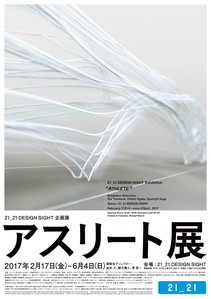
"ATHLETE" exhibition
An exhibition that looks at the powerful physicality of athletes from the perspective of design through images and footage and experience-oriented displays, Held until June 4, (Sun) 2017 at 21_21 DESIGN SIGHT.
Maybe a Kendama champion could be called an athlete. Or maybe even a chef or a game player who uses his mind. In Europe, chess is recognized as a sport, and there was a time when the Go game was part of the Asian Games.
Doping is one of the issues that are often discussed in sports philosophy. When you put aside the health aspects, the question regarding doping is about fairness. For instance, what if turned out that doping was good for the health, and what if everyone was allowed to do it? But there is something that makes us resist that scenario. What is wrong about a healthy person putting on an artificial leg and running shockingly fast?
The process of improving one's physicality
We sense it's wrong because learning through personal will and effort are important; it's no good if a person has it easy. So it seems to me that athletic ability is about the process of improving one's physicality.
I'm 170 cm tall and weigh 66-67 kg. I have a smallish body and my muscles are good for instantaneous motion. In hurdling, you run 400 m in about 40 seconds while jumping over 10 hurdles. It's a race that requires a certain level of endurance and technique, and there's a lot you can personally do to enhance your performance.
There are some sports such as basketball where effort alone is not enough. There's data that shows that 17% of American men aged 20 to 40 who are 213 cm tall or taller are NBA (National Basketball Association) athletes.
You can't change your body size and you can't change the rules of the game, but you can make an effort to use your body effectively to fit the requirements. Athletic ability is probably about physical excellence achieved through a series of efforts.
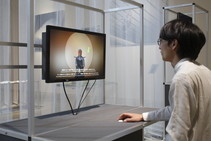
A display called "Athlete's Eyes" that shows how athletes in various games such as kendo sees his opponent.
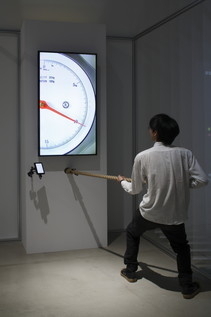
A display called "Physical Control" where visitors can experience how athletes control their bodies to exert strength, taking into factors such as timing, space and distance into account. Photographs: Keizo Kioku
An exhibition to make people slightly more aware of their bodies
The "ATHLETE" exhibition focuses on the athletic ability in everyone. Humans are capable of thinking about something while climbing the stairs; yet even ASIMO [the humanoid robot] cannot climb the stairs. Robots still have difficulty in picking up a paper cup but humans can tell the hardness of a paper cup the moment they touch it, and they can pick it up without squashing it.
There's a robot competition called "Amazon Picking Challenge" where the task is to pick and move things; since it's so difficult for robots to pick objects, most of the robots in the competition have been made to suck objects. Humans can do these things without thinking; I feel that athletic ability - such as the ability of a badminton player to hit a shuttlecock so fast so that it's impossible to hit back - lies in the unconscious realm.
Of course, there's a big difference in the ability to pick up a cup and the ability of a badminton player, but the difference is not as big as between a robot and a human. That's why I say everyone has athletic ability. In our everyday lives, we are not usually aware of our physicality, and this exhibition was aimed at making people a little bit more aware of their bodies.

The athlete's ability to pay attention to the small things
In the director's message to exhibition visitors, I wrote: The world that athletes live in is not completely different from the world of other people, but it is a world where slightly more attention is paid to the small things.
In gymnastics, the double turn and the triple turn look almost the same but are actually completely different. By knowing the details and understanding the differences, the quality of things can change so much. That's something that is true not only in the world of sports but in other genres as well. For example, ordinary people might not care whether the end of something is sharp or rounded, but for designers, the difference might be huge.
The similarity in the problems of doping and AI
Moving your body and enhancing your athletic ability is clearly beneficial for the health. And there are studies - which I think are true - that show that when you are physically active, there is an increase in the brain's nerve cells.
I also think that in the future, work that is not related to human physicality will no longer be work for humans. The issues of doping and AI (artificial intelligence) seem very similar because the central question underlying both is: What is the thing that only humans can do?
A designer at Mazda Motor once said that he uses software to design everything, but that in the final stage, he always makes a clay model so that he can touch it and confirm it. The biggest weakness of AI is that they cannot learn by recognizing the sense of touch. AI can understand from a variety of data that certain things are viewed as being lovely, but it cannot instinctively sense that something is inexplicably comfortable or beautiful. So I think that the great asset of humans is our sophisticated intuitiveness that comes from our physical senses.
Monitoring and controlling the body through practice
I think it's important for people to have their own checklist in monitoring their physical condition. Athletes notice when they feel a bit tired getting up in the morning or when the way they walk in a little different from normal; they have a checklist in their minds and they check off every item before making an overall decision on what to do. I guess we all do a similar thing when we get the first symptoms of a cold.
If photos were taken from your side and you could see those photos on your smartphone every five minutes, I think it would be possible for people to correct their slouched shoulders. Such a device would keep taking you by surprise. And the more you become aware of your posture, the more you will try to fix it, and eventually you will be able to keep a good posture without thinking about it.
In sports psychology, the principle is to take your attention away from the things that are uncontrollable and to focus on the things that you can control. For example, it's almost useless trying to do something about your inner feelings when you are nervous, because your feelings are invisible. But if your hands are shaking and your heartrate is increasing, you can think about ways to stop your hands from shaking and ways to lower your heart rate.
By controlling the specific behavior of your body, you ultimately control your inner feelings. I myself, from my experience as an athlete, have learned to act as if I am not nervous. The interesting thing is that when you practice doing this, you eventually learn not to become nervous.
The atmosphere of the streets will naturally change for the better
I just saw people running and riding on bicycles; I feel that the atmosphere of the streets in Japan has changed considerably. In the past, there were hardly any people running around the Tokyo Imperial Palace. I think that in the future, society will place more importance on physical fitness; change will probably come naturally so you don't need to force anything.
The word "sport" comes from the Latin word "deportare" [to carry away] which means to refresh and lighten up. Originally, deportare meant developing human talent through recreational activities which included art.
When you think about that, you realize that Roppongi already has many elements so perhaps all we need now are iron bars... (laughs) Perhaps you could have digital displays that show the bone structure of people as they walk by, or doors that suddenly become very heavy; it would be interesting if there were also devices that could make people aware of their bodies.
The advancement of technology will enhance athletic ability
The worst fear I have about the future of athletes is the possibility of doping that involves meddling with genes. It would be awful if, 30 years from now, the faces of all the runners in the 100m final resembled Bolt. I think we are inspired by sports because of the elements of pure coincidence and personal effort - I don't want those elements to be taken away.
In the future, there will probably be more amazing amateur athletes. Genius athletes are people who can discern the smallest differences and who can think of solutions to problems. Ordinary people can't do that and that's why they struggle, but with the advancement of technology, humans will be given help - technology will give us advice. Ordinary people may not be able to surpass the genius athlete but their abilities will rise to a considerably high level.
The new, the unusual, and the interesting
According to the book "Mind Time", the decision to move is made 0.2 seconds before the body starts moving and inside the brain, signals called readiness potentials are emitted 0.35 seconds earlier. So even before you decide to move your hand, the decision has already been made. I think the true wonder of humans lies in the realm of the unconsciousness, rather than in our ability to make logical decisions. I feel that there is something very human in that realm which in a sense, is different from the modern, intellectual world.

"Mind Time: The Temporal Factor in Consciousness" published by Iwanami Shoten
Written by American physiologist Benjamin Libet, the book is based on 40 years of study and presents a wide range of hypotheses on the human brain such as free will, mind-brain issues, unconsciousness and consciousness.
And that is precisely why I want to know more about humans. At the moment, I'm motivated to learn about the area where deportare and technology come together. Zeami said in "Fushikaden" that "something new", "something unusual" and "something interesting" are the three elements that move people. So that is the theme of my activities, and the exhibition we did recently was really in line with my interests.
Discussions are often made on humanness and technology as if there are two separate futures - one where people are growing organic vegetables in the field, and another where everything is done mechanically. But I feel that we could have a future where both humanness and technology blend together nicely.
Editor's thoughts
While walking around the "ATHLETE" exhibition, Tamesue-san mused about the people in the design industry, wondering if they gaze at works from afar and think about making adjustments. "Maybe they do the same kind of things [that athletes do]," he said. We hope that readers will visit the "ATHLETE" exhibition and discover their own athletic ability. (edit_kentaro inoue)




